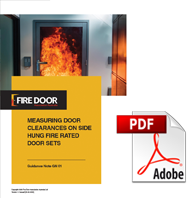Technical
Fire Door Compliance Fundamentals
Navigating Fire Door Compliance
Navigating Fire Door Compliance
Each FDAA Member strives to provide products compliant with the NCC, Australian Standards and relevant State Regulations.
Whilst the legal requirements for fire doors are pretty straight forward, fire doors regularly appear on the radar often when it comes to technical issues of compliance.
Common issues with Fire Doors
- Excessive door gaps
- Surety of Installed hardware compliance
- Doors not self-closing and/or self-latching
- Missing door or frame identification tag(s)
- Quoting doors without having all the relevant details
- Damaged doors – repair or replace
- Modifications made to fire doors post certification
- Differences of opinion for compliance matters
Fact Sheets
Fact sheets are developed by FDAA to provide guidance and a consistent response to matters where confusion arises or there are inconsistencies within the industry.
Prior to issuing a fact sheet, we collaborate with numerous stakeholders who have an interest of a view on the matter attempting to achieve a common outcome.
- How to correctly measure door gaps
- Approved Door Hardware
- Door hardware exemption for class 2 buildings
- Replacing fire doors and NCC Requirements
- Common maintenance faults with fire doors
- Fire door testing failure criteria
- Ordering the right fire door
Download: Guidance Note GN 01 – Measuring Door Clearances on Fire Rated Doors
Ensure compliance with AS 1905.1 by maintaining correct door clearances. Excessive gaps are a leading cause of fire door non-compliance and can compromise fire containment. This guide provides industry-approved methods for measuring and maintaining door clearances on hinged fire-rated door sets.
Who should read this? Building managers, door inspectors, installers, certifiers, and surveyors.
Download now to ensure your fire doors meet safety standards.



